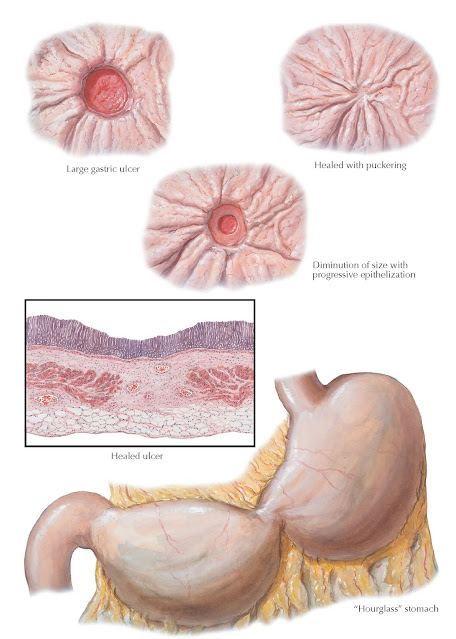HEALING OF GASTRIC ULCER
In most cases, gastric ulcers heal without complications. Inflammation and edema of the ulcer wall subside. As a result, the wall tends to become flattened. The fibrinopurulent exudate on the floor of the ulcer separates off, is discarded, and is replaced by healthy granulation tissue and, subsequently, fibrous tissue. The size and depth of the ulcer are reduced, chiefly by cicatrization (a process of wound healing that produces scar tissue) and the contraction of the fibroblasts on the floor and in the wall of the lesion. In addition, the epithelium grows inward from each margin to cover the area of ulceration. From this epithelial layer, projections down-ward eventually develop, forming simple glands. Finally, the entire area is covered by epithelium. As the contraction of the fibrous tissue progresses, a permanent scar and, in some cases, radiation of the mucosal folds develop. During the healing process the ends of the muscular coat may fuse with the muscularis mucosae. But, although severed ends of the muscular layer approximate one another as a result of the cicatrizing process, restitution of a muscular breach is never complete. This remains as permanent evidence of the original lesion. Puckering and radiating streaks on the serosal surface are further evidence of the scar produced in the healing process of the chronic gastric ulcer. This can be seen endoscopically, as medical practice suggests following these ulcers until healing occurs. The healing of a chronic gastric ulcer sometimes is complete, but not infrequently such ulcers are prone to recur, particularly if the newly formed mucous membrane is thin and its vascular supply deficient. In other cases the recurrence of ulcer symptoms is due to an entirely new ulcer, the scar of the original lesion remaining permanent.
The gradual
transition that occurs in the healing process of a chronic gastric
ulcer is demonstrable endoscopically and/or roentgenographically by following
the changes in the size of the niche corresponding to the crater of the ulcer.
As a result of the healing process, the niche diminishes until it has
completely disappeared. At other times, with clinical recurrence of symptoms,
the ulcer becomes reactivated and the niche reappears.
 |
| Plate 4-57 |
As a result
of the healing of a large gastric ulcer, a number of deformities may develop,
of which the bilocular or hourglass stomach is the best known. It is a
rare phenomenon occurring more frequently in women than men, in spite of the
higher incidence of gastric ulcer in men. With an hourglass stomach, the viscus
is divided into two cavities connected by a channel with a lumen of varying
size. The deformity originates mostly from a large ulcer, located in the corpus
of the stomach, which has healed by an extensive contracting scar formation. It rarely
causes complete obstruction, but the clinical symptoms are so unspecific,
particularly when the original ulcer is still active, that the diagnosis must
depend on the results of the x-ray examination. Radiographic evaluation may not
yield unequivocal answers, because constriction due to a malignant growth, temporary
spasms associated with an active gastric ulcer, and the rare gastric
manifestations of syphilis may simulate the x-ray appearance of an hour-glass
stomach caused by ulcer healing.




